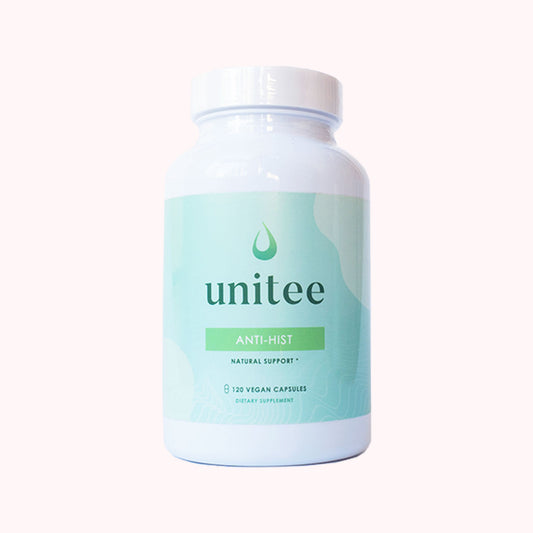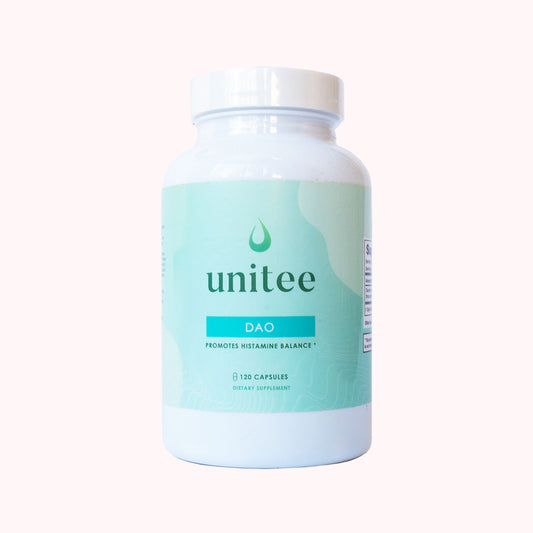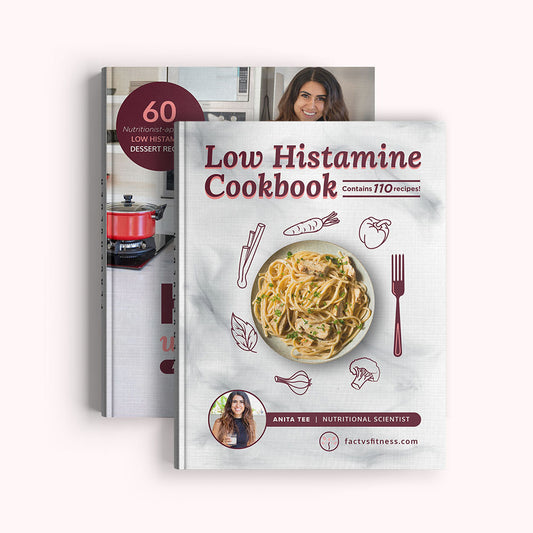Did your histamine intolerance start in your genes?
Constant headaches that often turn into migraines. Anxiety, irritability and mood disturbances. Nausea, digestive symptoms and reactions to even healthy foods. Constant runny nose, sneezing, itching eyes or skin…
These are typically the result of symptoms caused by allergies.
In some of you, however, they may not be related to common factors you’d expect to be allergic to that are present in the environment, like pollen and dust, for example. Instead, they are due to an allergy-mimicking response that is being stimulated within your body…
This type of immune reaction involves higher than normal histamine levels, which may come from a variety of sources - both externally consumed and internally produced.
Think about this: people often take antihistamines to ease symptoms of runny nose, hives and itching.
But, when histamine levels are chronically high, that's when these abnormal symptoms to develop and continue unabated.
As you may well know, histamine, even though it is causing so much trouble for you right now, is an important molecule in the body (1). It is involved in true allergic responses, the reactions involving immunity and your body’s defence system (2), in blood pressure control and even in mental health and chemical messenger systems (3).
Without histamine, these intricate processes would surely not work as they should (4)... but they don’t when histamine levels are too high, either.
There are a number of reasons that histamine levels build up in the body (5,6,7), such as an increase in histamine-containing food, too many histamine producing species of bacteria in the gut, taking medications that block the enzymes your body uses to degrade histamine, and even your genetics.
And that’s what we are going to get into today; what is it about your genes that leaves you vulnerable to histamine intolerance and all of the dreadful, and sometimes debilitating, symptoms you have to live with?
Genetic mutations in histamine intolerance
Your DNA dictates how, when, and why your body performs each and every function.
There are major environmental influences involved - but, it's important to know that you can change your environment, but you can't change the set of genes you were given!
Without getting into too much science, all you need to remember from your high school biology class is that your DNA is made up of two strands that provide the codes for each of these functions.
The codes are made using just four bases, dictated by the letters, A, C, G and T. Each combination of the letters tells a specific protein to perform a function.
In the histamine pathway, the enzyme that degrades histamine is called diamine oxidase or DAO. The gene that tells the body how much DAO to produce is called the AOC1/ABP1 gene (8). It is normally coded by C/C base pairs.
I know, we're getting a bit technical here...but, don’t worry, you don’t have to remember all of these letters, there’s no test at the end of this article, I promise!
It is, however, important to have even a little bit of an understanding of how your genes work, as it may help you to see where the imbalances in your body might be stemming from.
Ok, so, let's dive deeper...
Genes are built in their sequences when you begin growing in the womb and each code is carefully put together.
But, just as how it’s easy to make a typo when you write and email for example - you know what you want to type, but your fingers get tied up and you press the wrong button. Your body doesn’t have time to press the backspace, and so another letter might slip in every now and then.
In the histamine pathway, the normal C/C might become a C/T. This change from a C to a T is called a single nucleotide polymorphism or SNP, which is pronounced ‘snip’.
Because of this SNP, there is a slight change in the activation of the AOC1/ABP1 gene (that gene that tells the body how much DAO to produce).
As a result, a C/T SNP reduces the capacity of the body to make sufficient levels of DAO (9).
There’s another common SNP in this process. Instead of Cs, the code becomes a T/T coupling of the bases; this T/T combination has even less capacity to stimulate DAO production than C/T (10).
The end result is that you simply don’t have enough DAO to break down even normal levels of histamine in the body, which is called primary DAO insufficiency (10).
Your levels of histamine slowly increase over time, and the reason you now have the symptoms you do is because these levels have reached a point that your body can no longer tolerate.
One of the primary therapies available for DAO insufficiency is to use a DAO enzyme supplement which can assist in breaking down incoming histamine such as from food or through the environment. This method tends to increase tolerance to histamine and reduce histamine associated symptoms.
DAO is not the only enzyme the body uses to degrade histamine: HNMT is often not referred to as heavily as DAO because it is more specific to histamine levels in the central nervous system (11), i.e. the brain and spinal cord, whereas DAO activity is widespread throughout the body (12).
HNMT SNPs are also fairly common (13,14), as are other genes coding for histamine receptor responses (15), which can change the way histamine binds to them and elicits the response.
If you do have an issue with histamine intolerance, a genetic test for these SNPs could be very helpful in determining the treatment you, as an individual, may require.
Should you not have access to these tests there are still ways you can reduce the effects that histamine has on your body.
Simple ways to reduce histamine symptoms
One of the most impactful ways to reduce your symptoms in a short period of time is to change your diet.
By reducing the histamine load in your gut, you can allow your body to better process the histamine levels it is already trying to deal with.
Following a low histamine diet, carefully selecting the foods you eat from this histamine intolerance foods list, can be very helpful in managing your symptoms (16, 17, 18).
It's important to remember that you don't just want to eliminate high histamine foods, but you also want to eliminate foods that trigger histamine release in the body or are bacterially converted to histamine, as well as implementing foods that are anti-inflammatory and stabilize histamine-releasing mast cells.
Sound confusing? Don't worry, I got you. Click below to grab my free Low Histamine Diet eBook which lists all of the foods you should and shouldn't be eating.
Another way to reduce your histamine load is through supplementation. By incorporating DAO enzymes, and adding in a natural antihistamine and mast-cell stabilizers (which reduces the release of histamine from your body), you will both produce less histamine and degrade more histamine (19, 20, 21). This combination helps my clients to eat a wider variety of foods with drastically fewer symptoms.
Healing the gut, reducing inflammation and managing stress are also important for overcoming histamine intolerance. Focussing on gut health is a key aspect that's often left behind in histamine intolerance sufferers, as the symptoms may not directly seem gut-related.
Fortunately, your health is not dictated by your genes; you have the ability to change what you eat and how you live so that those little ‘typos’ don’t dictate your ability to live healthy and well.
Want to learn more? Click below for a guide to reducing your histamine intolerance symptoms and eliminating histamine intolerance, for good!
References:
1. Heidari, A., et al. Mutations in the histamine N-methyltransferase gene, HNMT, are associated with nonsyndromic autosomal recessive intellectual disability. Hum Mol Genet. 2015 Oct 15; 24(20): 5697–5710. https://www.ncbi.nlm.nih.gov/pmc/articles/PMC4581600/
2. Jutel M., et al. Immune regulation by histamine. Curr Opin Immunol. 2002 Dec; 14(6):735-40. https://www.ncbi.nlm.nih.gov/pubmed/12413523/
3. Nahanuma, F., et al. Histamine N-methyltransferase regulates aggression and the sleep-wake cycle. Scientific Reportsvolume 7, Article number: 15899 (2017). https://www.nature.com/articles/s41598-017-16019-8
4. Nishino, S. et al. Decreased CSF histamine in narcolepsy with and without low CSF hypocretin-1 in comparison to healthy controls. Sleep 32, 175–180 (2009). https://www.ncbi.nlm.nih.gov/pubmed/19238804?dopt=Abstract
5. Comas-Baste, O., et al. Histamine and Other Biogenic Amines in Food. From Scombroid Poisoning to Histamine Intolerance. Biogenic Amines. 2018. https://www.intechopen.com/books/biogenic-amines/histamine-and-other-biogenic-amines-in-food-from-scombroid-poisoning-to-histamine-intolerance
6. Gardini F, Özogul Y, Suzzi G, Tabanelli G, Özogul F. Technological factors affecting biogenic amine content in foods: A review. Frontiers in Microbiology. 2016;7:1218. https://www.ncbi.nlm.nih.gov/pubmed/27570519
7. Russo P, Spano G, Arena MP, Capozzi V, Fiocco D, Grieco F, et al. Are consumers aware of the risks related to biogenic amines in food? In: Mendez-Villas A, editor. Current Research, Technology and Education Topics in Applied Microbiology and Microbial Biotechnology. Badajoz: Formatex Research Center; 2010. pp. 1087-1095. https://pdfs.semanticscholar.org/7f12/9e6b3fed13055454eb6a4c75dc42fd4b9e33.pdf
8. Ayuso, P., et al. Genetic variability of human diamine oxidase: occurrence of three nonsynonymous polymorphisms and study of their effect on serum enzyme activity. Pharmacogenet Genomics. 2007 Sep;17(9):687-93. https://www.ncbi.nlm.nih.gov/pubmed/17700358
9. Jones, B., et al. Genetic Variation in the Histamine Production, Response, and Degradation Pathway Is Associated with Histamine Pharmacodynamic Response in Children with Asthma. Front. Pharmacol., 04 January 2017. https://www.frontiersin.org/articles/10.3389/fphar.2016.00524/full
10. Maintz, L., et al. Association of single nucleotide polymorphisms in the diamine oxidase gene with diamine oxidase serum activities. Allergy. 2011 Jul;66(7):893-902. https://www.ncbi.nlm.nih.gov/pubmed/21488903?dopt=Abstract
11. Horton, J. R., Sawada, K., Nishibori, M., Zhang, X. & Cheng, X. Two polymorphic forms of human histamine methyltransferase: structural, thermal, and kinetic comparisons. Structure 9, 837–849 (2001). https://www.ncbi.nlm.nih.gov/pubmed/11566133
12. Bieganski, T. et al. Distribution and properties of human intestinal diamine oxidase and its relevance for the histamine catabolism. Biochim Biophys Acta756, 196–203 (1983). https://www.ncbi.nlm.nih.gov/pubmed/6403048
13. Pang, Y., et al. Theoretical 3D model of histamine N-methyltransferase: insights into the effects of a genetic polymorphism on enzymatic activity and thermal stability. Biochem Biophys Res Commun. 2001 Sep 14;287(1):204-8. https://www.ncbi.nlm.nih.gov/pubmed/11549275
14. Hon, Y., et al. Endogenous histamine and cortisol levels in subjects with different histamine N-methyltransferase C314T genotypes : a pilot study. Mol Diagn Ther. 2006;10(2):109-14. https://www.ncbi.nlm.nih.gov/pubmed/16669609
15. Sander, L., et al. Selective expression of histamine receptors H1R, H2R, and H4R, but not H3R, in the human intestinal tract. Gut. 2006 Apr; 55(4): 498–504. https://www.ncbi.nlm.nih.gov/pmc/articles/PMC1856162/
16. Son, J., et al. A Histamine-Free Diet Is Helpful for Treatment of Adult Patients with Chronic Spontaneous Urticaria. Ann Dermatol. 2018 Apr; 30(2): 164–172. https://www.ncbi.nlm.nih.gov/pmc/articles/PMC5839887/
17. Wantke F, Gotz M, Jarisch R. Histamine-free diet: treatment of choice for histamine-induced food intolerance and supporting treatment for chronic headaches. Clin Exp Allergy 1993;23:982–5. https://www.ncbi.nlm.nih.gov/pubmed/10779289
18. Wantke F, Gotz M, Jarisch R. [The histamine-free diet]. Hautarzt 1993;44:512–6 (in German). https://www.ncbi.nlm.nih.gov/pubmed/8376104
19. Yacoub, M., et al. Diamine Oxidase Supplementation in Chronic Spontaneous Urticaria: A Randomized, Double-Blind Placebo-Controlled Study. Int Arch Allergy Immunol 2018;176:268–271. https://www.karger.com/Article/PDF/488142
20. Izquierdo-Casas, J., et al. Diamine oxidase (DAO) supplement reduces headache in episodic migraine patients with DAO deficiency: A randomized double-blind trial. Clinical Nutrition. 2019. 8(1):152-158. https://www.sciencedirect.com/science/article/pii/S0261561418300141
21. Schnedl, W., et al. Diamine oxidase supplementation improves symptoms in patients with histamine intolerance. Food Sci Biotechnol (2019). https://link.springer.com/article/10.1007/s10068-019-00627-3







